This is the first in a 7 part series. This time, all omissions, mistakes, and errors are all mine. Other installments can be found here:
- The Interceptor Guitar & Bass: 1st X-body Interceptor II
- The Interceptor Guitar & Bass: 1st X-body Interceptor III
- The Interceptor Guitar & Bass: 2nd X-body Interceptor HH
- The Interceptor Guitar & Bass: 3rd style Interceptor HSS
- The Interceptor Guitar & Bass: 3rd style Interceptor SSS
- The Interceptor Guitar & Bass: The Interceptor Bass
The information provided comes from sources which I’d like to acknowledge here: Gabe Dellevigne, Dale Hyatt (deceased), and of course the Rarebird pages in the Registry for guitars and basses. The latter pages do however have some errors (I believe) which I hope to correct here.
So how came the Interceptor into existence? Transport yourself back to the early eighties. Whereas nowadays we are very much endeared with vintage instruments (Stratocaster, Telecaster, Les Paul, SG, etc.), the guitar market in those days had moved to rather non-traditional designs. Those were the days of big-hair bands, wielding their Ibanez Iceman or B.C. Rich Mockingbird. Eddie was “Jump”-ing around on his original Frankenstrat while Charvel and Jackson were also building guitars for him and other shredders. Dale Hyatt realized that G&L needed to do something to address that market segment.
It took some time, but G&L came up with a beautiful X-shape body, Dual Fulcrum Vibrato, and sickle shaped headstock with G&L teat, affectionally called “can opener” by Dale Hyatt. As far as the headstock shape was concerned, there were even ideas floating around to include an actual can opener along with a cigarette holder! You cannot say the folks at G&L didn’t have a sense of humor. The instrument looked pretty futuristic indeed! And unlike common lore, Leo Fender was fully aware of its development and actually approved the design.
The first two prototypes built had serial numbers G000014 and G000015 and were assembled on May 26, 1983. Although both were never entered in Dale’s sales log, what is known is they have a Red-over-Black paint scheme (since the Red is still transparent, it is more like Clear Red/Black) and maple fingerboards. For S/N G000015 it is also known that it has gold hardware and 3 Nighthawk/Skyhawk pickups.
The first officially logged X-body Interceptor has S/N G000013, again in Red-over-Black with gold hardware and maple fingerboard, and was entered in the sales log June 7, 1983. As for S/N G000014, it is unknown what the pickup configuration is for G000013. Note that this guitar is built around the same time the price list for June, 1983 was published. The first page of this price list includes an entry for the Limited Edition Model Interceptor I II & III:

If we assume the model designation follows the G&L tradition, the Interceptor I would only have a single pickup. There seems to be no Interceptor in existence with such a pickup configuration so it is unknown what pickup would actually have been used. The Interceptor II has 2 HG-2R “Angled Offset” humbuckers, which most of us know better as the pickups used in the G&L Cavalier. And the Interceptor III is the one with the 3 Nighthawk/Skyhawk pickups as were used for G000015.
The Interceptor was included in similar fashion in the August 1, 1983 price list:

Note that to get your hands on one of these babies, you would not find one as a demo on the sales floor of your favorite guitar store or hanging on the wall. Rather, one needed to ”contact the company direct or your representative.”
On August 24, 1983, 4 instruments were entered in the sale log, all built for people at G&L, all with Red-over-Black finish over a flamed maple body and gold hardware. S/N G000001, the lowest G&L S/N possible, was built for George Fullerton and is an Interceptor III with maple fingerboard. S/N G000002 (topic of a later post) was built for Leo Fender and a little bit of an aberration in that the Clear Red on this Interceptor II is more of a Burgundy. It also has an ebony fingerboard. S/N G000003 was built for Dale Hyatt and has the same specs as the Interceptor built for George. Finally, S/N G000004 was built for shop foreman Lloyd Chewning. It is known it has a maple fingerboard but the pickup combination is not logged. But I can make a guess.
That guess is informed by this marketing slick from late 1983:
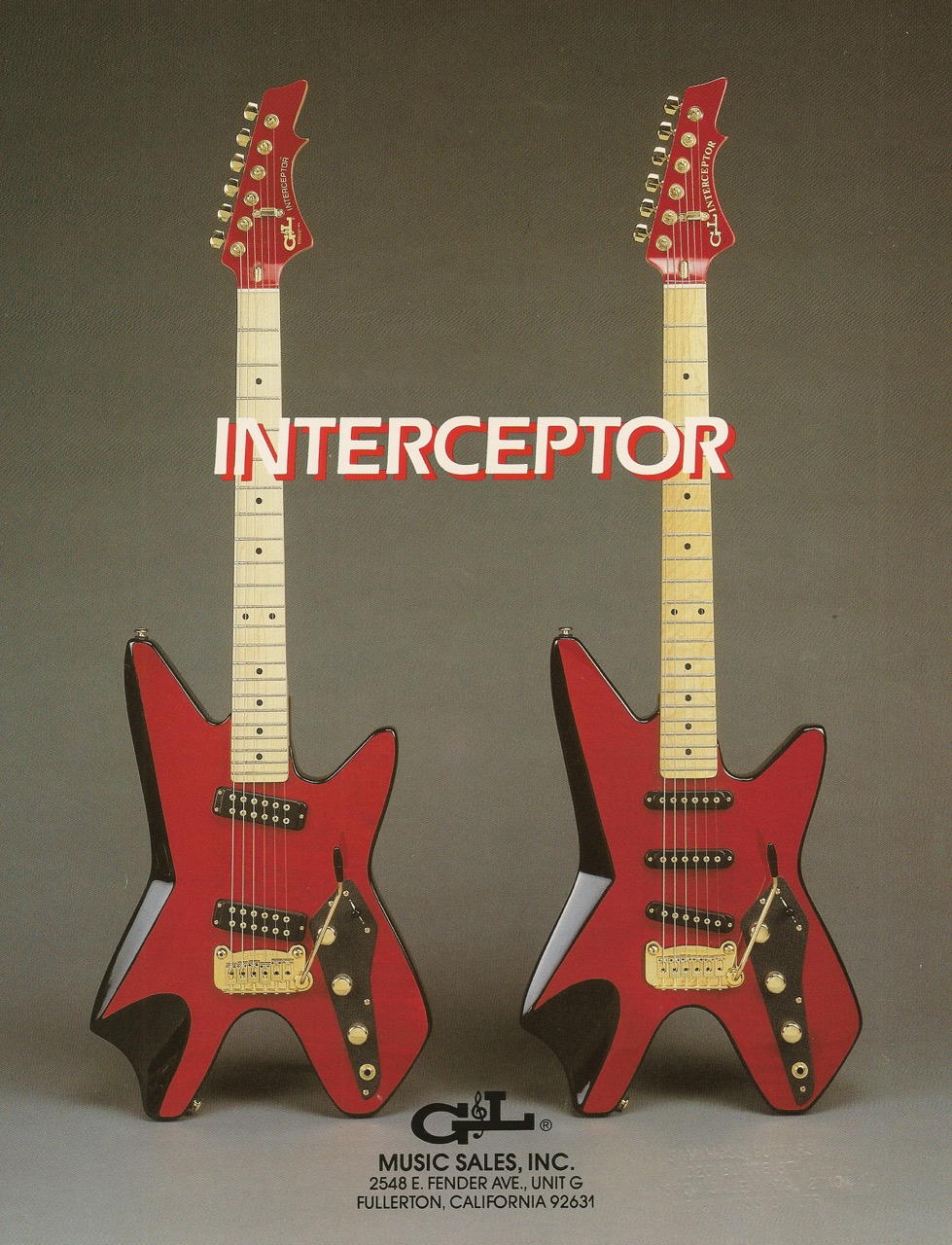
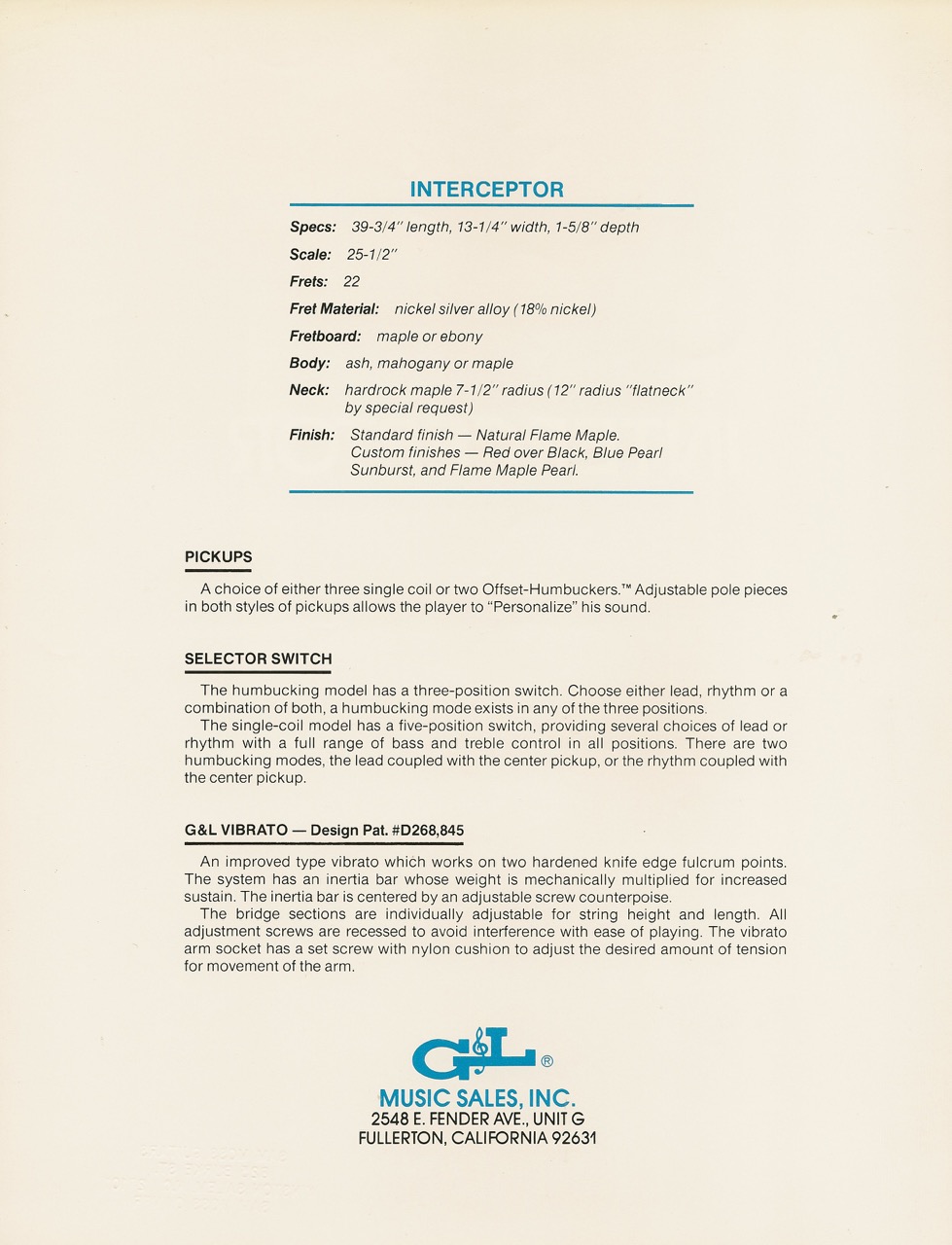
You’ll notice both have maple fingerboards. And all maple fingerboard Interceptors above for which the pickup combination is known are Interceptor IIIs, including Dale’s S/N G000003 used in the picture. For the one with the Cavalier pups, that leaves either S/N G000013, S/N G000014, or Lloyd’s S/N G000004. So my guess would be that Lloyd’s has HG-2R “Angled Offset” humbuckers and would be an Interceptor II.
The first production X-body Interceptor came off the line on October 6, 1983. Although I do not know the serial number of this guitar, what is known is that it has gold hardware, #2 neck with maple fingerboard, and just a Clear Red finish. Another noteworthy guitar is the Natural Gloss Interceptor III featured in the header of the Rarebird page with S/N G015248. Although about all early X-body Interceptors with Natural Gloss finish have figure in spades, this is likely the most figure you will find in a maple body on this model. No wonder that particular Interceptor was used for display at the (1984?) NAMM show. The registry entry claims this guitar has a cocobolo fingerboard. However, my reliable sources have it as actually being unstained Macassar Ebony, more in line with the materials used in the day.
The Interceptor I had disappeared when the January 15, 1984 price list was released.:


Instead we find separate entries for an Interceptor with either 3 single coil pickups or 2 humbucking pickups. It now came standard with a #2 neck, i.e. 7½” fingerboard radius and 1⅝” nut width. And explicit prices were stated of course. On the second page it lists the finishes available for both guitars as well as the newly introduced Interceptor Bass listed at the bottom of the first page: “Finishes for INTERCEPTOR Guitars and Basses are available in: Natural Flame Maple as a standard finish. For Red-over-Black, Blue Pearl Sunburst, and Pearl Flame finish, add $100.00 to Suggested Retail”. The Interceptor Bass was also rather futuristically shaped and will be covered in more detail in a later post. The only advertisements I have been able to locate featuring the Interceptor Bass are the so-called ”Kings of the Road” campaign and an ad where one is paired with an L-2000, both with a Kahler 2410 4-string Bass Tremolo, a super rare configuration. I believe both of these ran somewhere around the 1984-1985 time frame:
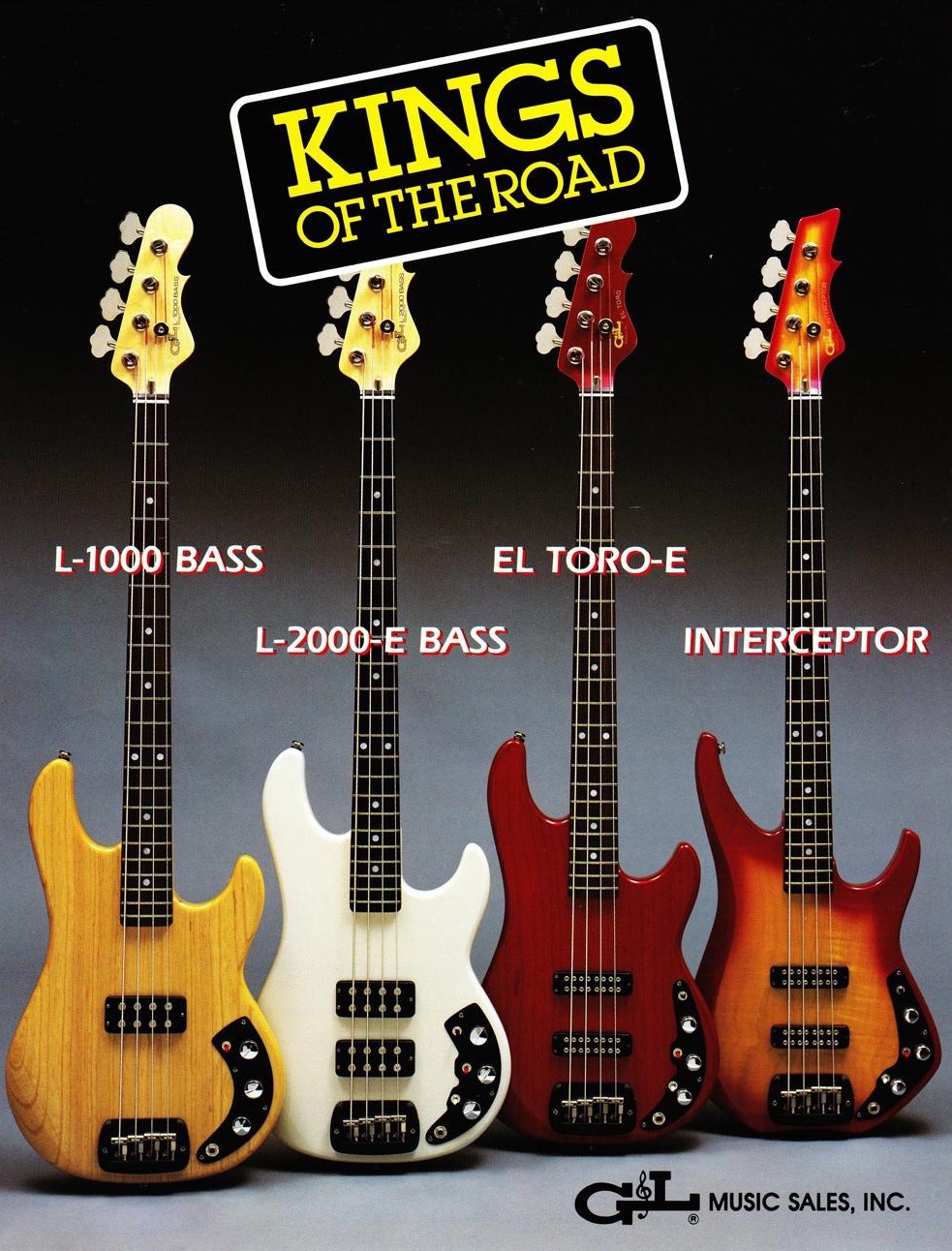
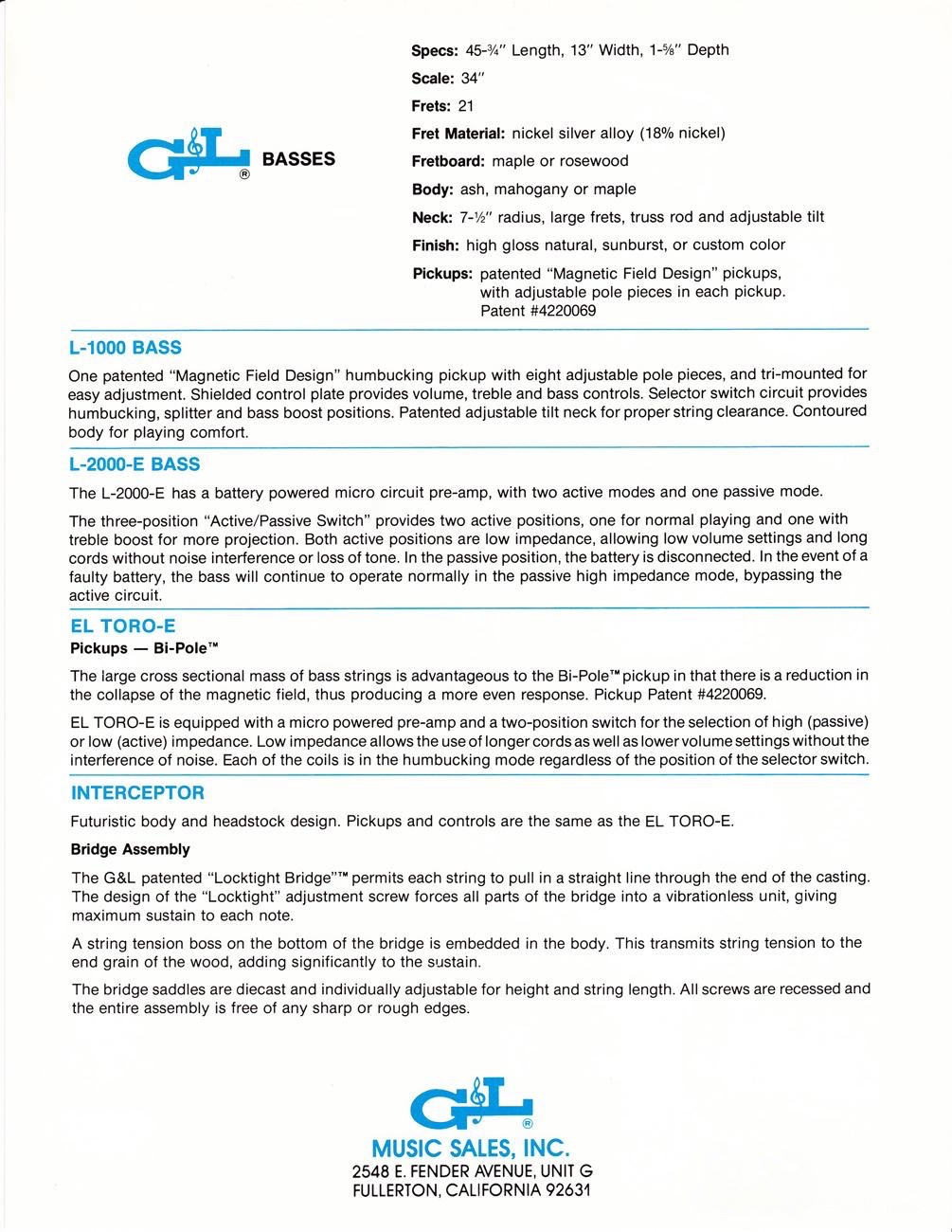
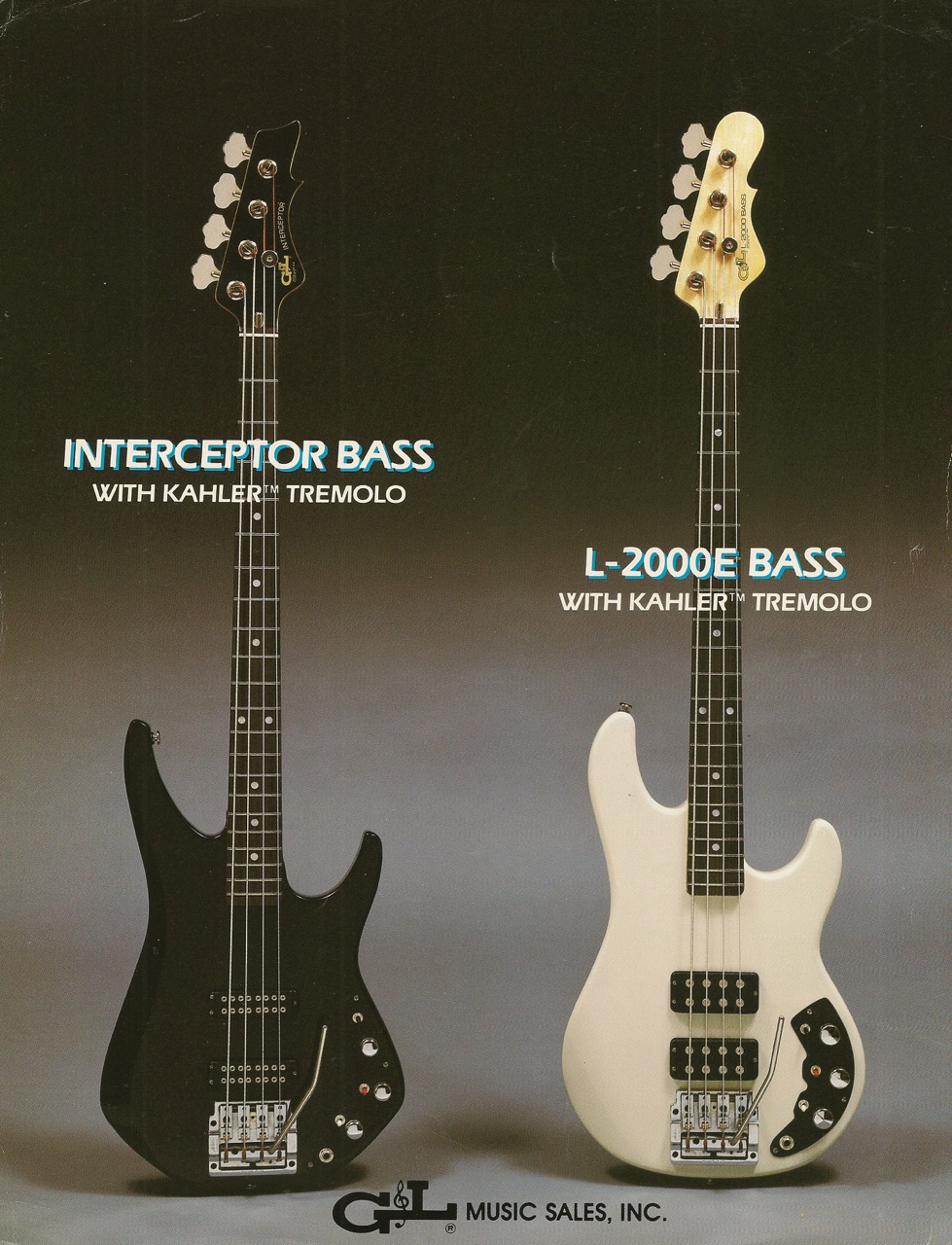
The January 15, 1985 price list only retains Red/Back from the above finish options but adds Black and White as well as an additional option for the vibrato. Now the Interceptor could be had with either the Dual Fulcrum Vibrato, as before, but also with a Kahler 2320 flat mount fine-tuner vibrato. Not a complete surprise when one recalls the popularity of these units in those days when Kahler and Wilkinson were all in fierce completion with Floyd Rose. Dive bombing and guitar pyrotechnics were the thing. But notice the $60 you had to pay extra if you wanted to get the black chromed version of the Kahler 2320 unit! The Interceptor now also came with a #3 neck, i.e. 12” radius and 1¾” nut width:


Nothing had effectively changed in the September 1, 1985 price list:


Around that time, G&L also ran a campaign featuring Ric Olsen of Berlin, most famous for ”Take Your Breath Away”, the theme song for the 1986 ”Top Gun” Tom Cruise/Kelly McGillis blockbuster.
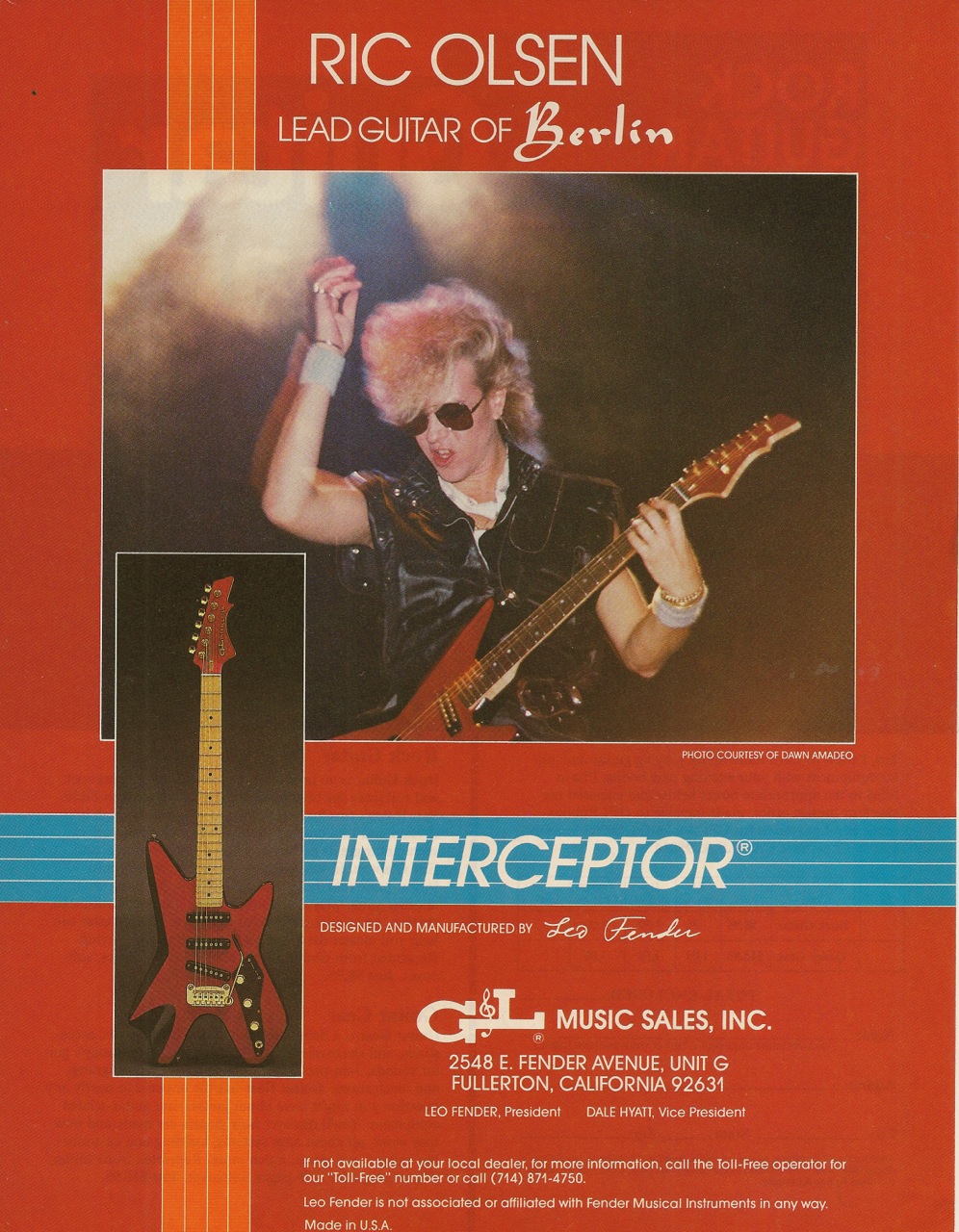
Another “famous” 1st X-body Interceptor was Charles Meussdorffer, better known as Jack Charles and guitarist for the Portland, OR band ”Quarterflash”. You can watch him play his trusty Interceptor II at around the 1:20 mark in this video:
[video]https://youtu.be/BaSHtnLvdks[/video]
Anyway, that guitar, with S/N G011903, still creates some raw emotions in me since it is the subject of a deal gone horribly south due to an unethical eBay seller. BTW, did you know Jack Charles Meussdorffer is the man behind Phantom Guitarworks? Go check out his Vox inspired models!
The 1st style X-body had a fundamental (mechanical) weakness in that there was so little wood behind the DFV units, that area was very prone to the formation of hairline cracks. This problem was actually recognized very early on and attempts tp solve it started in late-summer/early-fall of 1984. So although popular believe has it the 2nd style X-body Interceptor was introduced in early-1986, the evolution towards that configuration actually started well before that. Over time, and beyond more wood behind the vibrato unit, the horns became a little longer, the controls were rear-mounted (buyers hated the control plate; it was just deemed to be ugly), and the Kahler 2320 became the “advertised” vibrato unit although also the Interceptor was still available in other (vibrato) configurations. In addition, the Interceptor II had undergone a significant change in that the 2 humbuckers now were Schaller humbuckers instead of the HG-2R used before:


The price list for June 1, 1986 reflected the Interceptors in about the same way as before save for the #4 neck, with its 1¾” nut width and 25” radius:


The price list for September 1, 1987 was no different, and the last mention of the X-body Interceptor:


So how many X-body were actually built? According to Dale, who got the numbers by going through his sales log matching dates and options, 95 1st style X-body Interceptors and 19 2nd style X-body Interceptors were built. No hard numbers are known because the sales log does not indicate what kind of body the instrument had. And contrary to popular belief that no X-body Interceptors were built after 1986 because Leo didn’t like the body shape, the real reason the X-body disappeared was that the model simply did not sell well enough. But Dale would never forego a good sale so one should be aware there were 2 X-body Interceptors built as late as the summer of 1991. (As a side note, this is also true for the F-100. Although it disappeared from the price list in 1986, they were ordered and built up to November 1991!)
The 3rd-style Interceptor was introduced in 1988 although 12 were built in 1987, and was announced with the January 1, 1988 price list, where the Interceptor appeared on the 2nd page:

This guitar now has a more Strat like body shape while the teat disappeared from the sickle headstock which was redesigned by Ray Ransdell. The Interceptor now came in 3 different configurations. The Interceptor HH and Interceptor SSS were effectively hold-overs from before with 2 (Schaller) humbuckers and 3 Skyhawk pickups, respectively. In addition, the Interceptor now also came in an HSS configuration with a Schaller humbucker in the bridge and 2 Skyhawk pups in the middle and neck position. In effect, with its 3 pickup on/off switches, it looked very much as the Invader except for the body shape. The ad slick below showing this configuration also features the Leo Fender Fine-Tuner Vibrato which became available as another bridge option (see price list above):
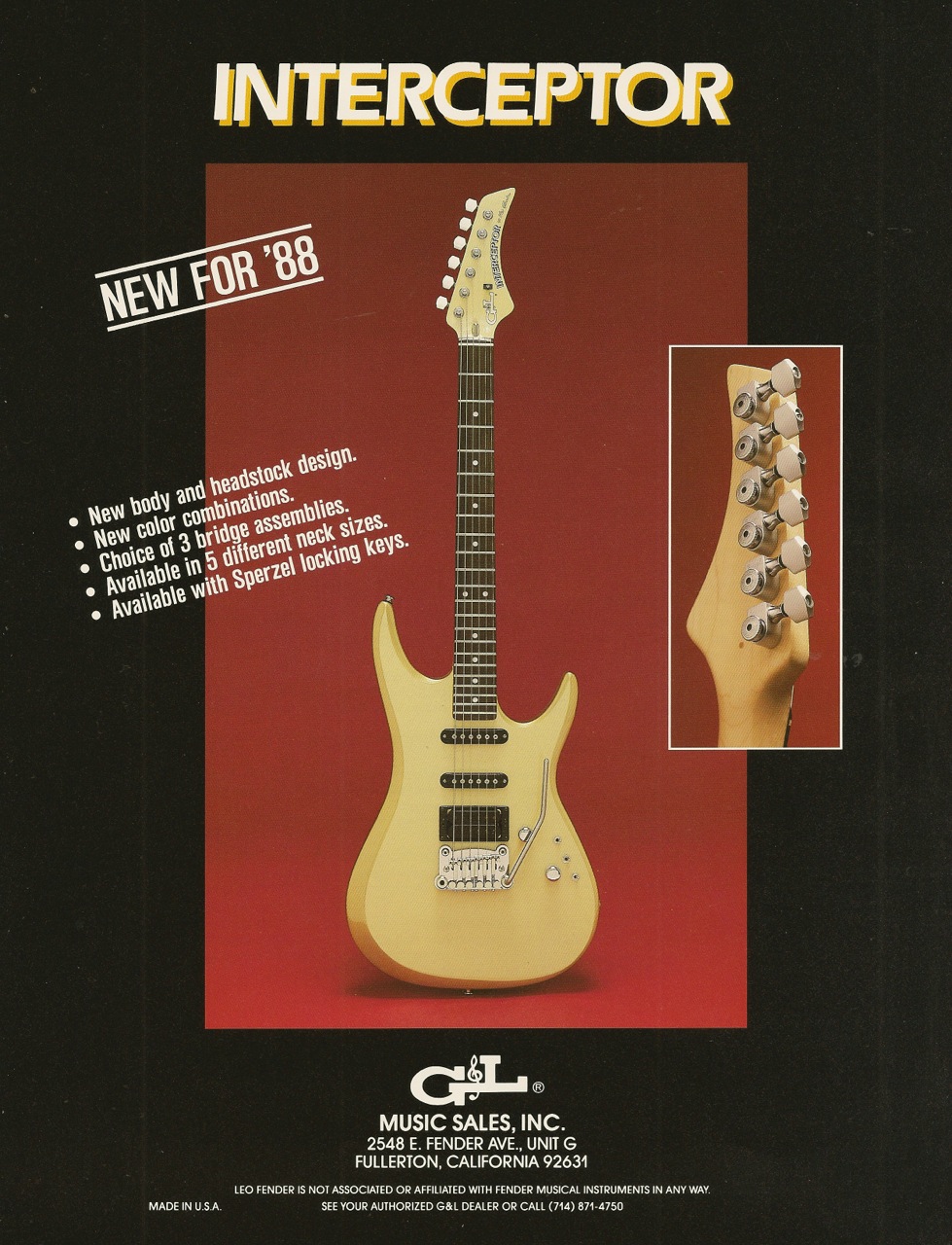
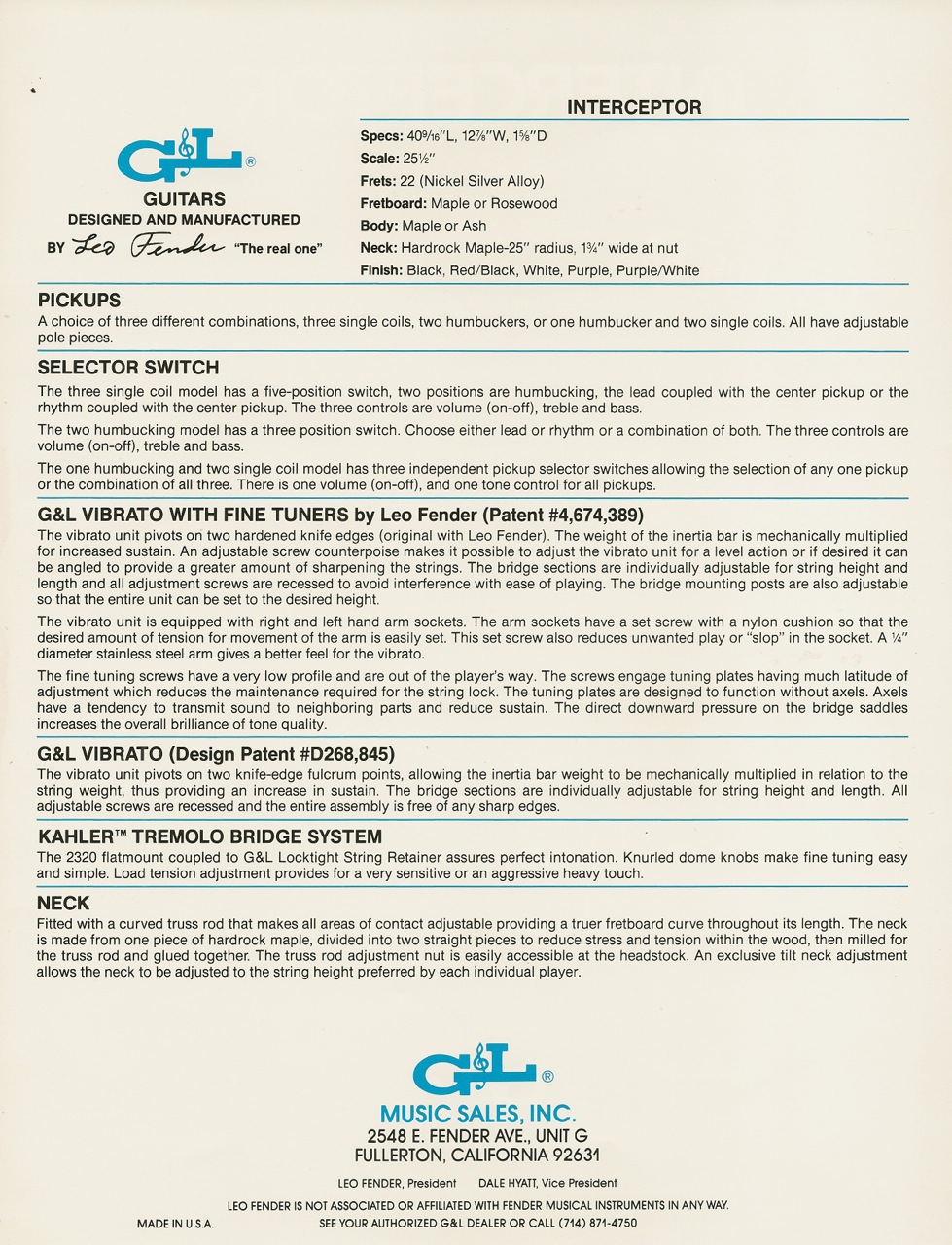
At the same time the Interceptor Bass underwent a small change too in that the controls were rear-mounted as seen in the 1988 catalog:
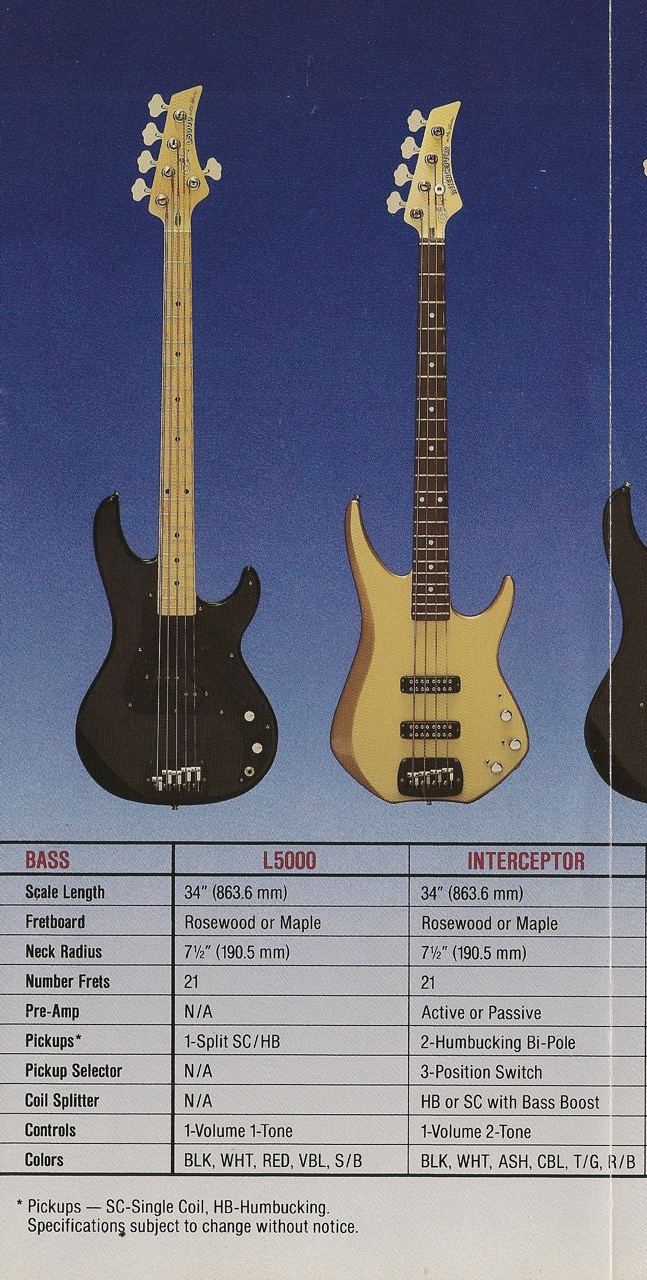
The 3rd-style was the final configuration for the Interceptor and remained the same until the model was discontinued at the end of 1991 after Dale retired from G&L. Just so one can see price developments, here the last 3 price list for June 15, 1988:


January 1, 1990:


and January 1, 1991:


So you think there are vastly more 3rd-style Interceptors than X-body Interceptors, right? Wrong! The 3rd-style Interceptor is actually as rare as the 1st X-body Interceptor with only 92 produced. This brings the total number of interceptors built between May 26, 1983 and July 1, 1991 to a mere 206. And this number includes all the transition models out there. Check out the Interceptors section of the Gallery and you will find several of them. Looking further on the internet, you might find Rod Dean's beautiful Clear Red/Black Interceptor with a round lower bout like the 3rd-style Interceptor but still the same arm cut-out as the X-body Interceptors. Or a 3rd-style Interceptor with an HHS configuration. Any Interceptor is a rare find, no matter how you look at it.
This time was a lot of numbers. Next time some actual instrument will be shown: Leo Fender's Interceptor II.
- Jos